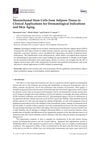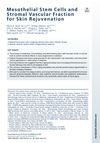Search
forLearn
2 / 2 resultslearn Osteopontin
signaling protein that, when suppressed, may grow hair by reducing inflammation and stem cell loss
Research
5 / 1000+ resultsresearch Evaluation of the Level of Serum Interleukins (IL-2, IL-4, IL-15, and IL-17) and Its Relationship with Disease Severity in Patients with Alopecia Areata
Interleukin levels are higher in alopecia areata patients but don't predict disease severity or duration.

research Drug Repurposing: A Promising Approach for Patients With Angina and Non-Obstructive Coronary Artery Disease (ANOCA)
Using existing drugs for new purposes could be a cost-effective way to treat chest pain and non-clogged heart arteries, with some drugs for lung blood pressure showing promise but needing more testing.

research Regulatory T Cells: The Many Faces of Foxp3
Foxp3 is crucial for regulatory T cell function, and targeting these cells may help treat immune disorders.

research Mesenchymal Stem Cells from Adipose Tissue in Clinical Applications for Dermatological Indications and Skin Aging
Fat-derived stem cells show promise for skin repair and reducing aging signs but need more research for consistent results.

research Mesothelial Stem Cells and Stromal Vascular Fraction for Skin Rejuvenation
Adipose-derived stem cells show potential for skin rejuvenation and wound healing but require more research to overcome challenges and ensure safety.
Community Join
3 / 3 resultscommunity NMN Promotes Cell Proliferation and Hair Growth by Reducing Oxidative Stress
NMN shows promise in promoting hair growth by reducing oxidative stress and weakening androgens. It may be a beneficial addition to hair loss treatments like Minoxidil and Finasteride.

community Compressed part of research of theory of androgenic/anabolitic balance. AGA h-responders analytic. Theory of physio-metabolitic method of anti AGA treatment
The treatment for androgenetic alopecia involves using finasteride and minoxidil with intense exercise and cold exposure to boost metabolism and reduce androgenic effects, potentially leading to hair regrowth. This approach may activate biological pathways for improved hair and overall health.
community UPDATE: The theory that explains everything. Please help me make this big!
Hair loss theory involves 3alpha-hydroxysteroid reductase (3AHD) converting DHT to androstenol. Discussion explores potential treatments and encourages more research.